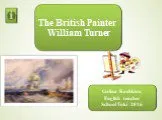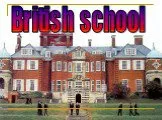Слайд 1Samuel de Champlain

Слайд 2Samuel de Champlain born (ca. 1567 – December 25, 1635), "The Father of New France", was a French navigator, cartographer, draughtsman, soldier, explorer, geographer, ethnologist, diplomat, and chronicler. He founded New France and Quebec City on July 3, 1608. Born into a family of master mariners, Champlain, while still a young man, began exploring North America in 1603 under the guidance of François Gravé Du Pont. From 1604-1607, Champlain participated in the exploration and settlement of the first permanent European settlement north of Florida, Port Royal, Acadia (1605). Then, in 1608, he established the French settlement that is now Quebec City. Champlain was the first European to explore and describe the Great Lakes, and published maps of his journeys and accounts of what he learned from the natives and the French living among the Natives. He formed relationships with local Montagnais and Innu and later with others farther west (Ottawa River, Lake Nipissing, or Georgian Bay), with Algonquin and with Huron Wendat, and agreed to provide assistance in their wars against the Iroquois. In 1620, Louis XIII ordered Champlain to cease exploration, return to Quebec, and devote himself to the administration of the country. In every way but formal title, Samuel de Champlain served as Governor of New France, a title that may have been formally unavailable to him due to his non-noble status. He established trading companies that sent goods, primarily fur, to France, and oversaw the growth of New France in the St. Lawrence River valley until his death in 1635. Champlain is also memorialized as the "Father of New France" and "Acadia", and many places, streets, and structures in northeastern North America bear his name, or have monuments established in his memory. The most notable of these is Lake Champlain, which straddles the border between the United States and Canada. In 1609 he led an expedition up the Richelieu River and explored a long, narrow lake situated between the Green Mountains of present-day Vermont and the Adirondack Mountains of present-day New York; he named the lake after himself as the first European to map and describe it.

Слайд 3Early years Champlain was born to Antoine Champlain (also written Anthoine Chappelain in some records) and Marguerite Le Roy, most likely in the port town of Brouage, in the French Province of Saintonge. The exact date and location of Champlain's birth are unknown, and all the vital records of Brouage were lost in a fire in 1690. In his 1851 book, Pierre Damien Rainguet, a Catholic priest in Saintonge, estimated Champlain's birth year to be 1567, without giving any reference or raw data he used for his estimate.In 1870, the Canadian Catholic priest Laverdière, in the first chapter of his Œuvres de Champlain, accepted Rainguet's estimate and tried to give details justifying it, but his calculations were based on many assumptions now believed or proven to be incorrect. Although Léopold Delayant (member, secretary, then president of l'Académie des belles-lettres, sciences et arts de La Rochelle) wrote as early as 1867 that Rainguet's estimation was wrong, the books of Rainguet and Laverdière have had a significant influence: the 1567 date was carved on numerous monuments dedicated to Champlain, and has been widely republished as true. In the first half of the 20th century, some authors disagreed and chose 1570 or 1575 instead of 1567. In 1978 Jean Liebel published groundbreaking research about these estimates of Champlain's birth year and concluded, "Samuel Champlain was born about 1580 in Brouage."Liebel asserts that some authors, including the Catholic priests Rainguet and Laverdière, preferred years when Brouage was under Catholic control (which include 1567, 1570, and 1575). Champlain claimed to be from Brouage in the title of his 1603 book, and to be Saintongeois in the title of his second book (1613). He belonged to either a Protestant family, or a tolerant Roman Catholic one, since Brouage was most of the time a Catholic city in a Protestant region, and his Old Testament first name (Samuel) was not usually given to Catholic children.The exact location of his birth is thus also not known with certainty, but at the time of his birth his parents were living in Brouage,near Rochefort in the French province of Saintonge. Born into a family of mariners (both his father and uncle-in-law were sailors, or navigators), Samuel Champlain learned to navigate, draw, make nautical charts, and write practical reports. His education did not include Ancient Greek or Latin, so he did not read or learn from any ancient literature. As each French fleet had to assure its own defense at sea, Champlain sought to learn fighting with the firearms of his time: he acquired this practical knowledge when serving with the army of King Henry IV during the later stages of France's religious wars in Brittany from 1594 or 1595 to 1598, beginning as a quartermaster responsible for the feeding and care of horses. During this time he claimed to go on a "certain secret voyage" for the king,and saw combat (including maybe the Siege of Fort Crozon, at the end of 1594).By 1597 he was a "capitaine d'une compagnie" serving in a garrison near Quimper.

Слайд 4Early travels In 1598, his uncle-in-law, a navigator whose ship Saint-Julien was chartered to transport Spanish troops to Cadiz pursuant to the Treaty of Vervins, gave Champlain the opportunity to accompany him. After a difficult passage, he spent some time in Cadiz before his uncle, whose ship was then chartered to accompany a large Spanish fleet to the West Indies, again offered him a place on the ship. His uncle, who gave command of the ship to Jeronimo de Vallebrera, instructed the young Champlain to watch over the ship.[17] This journey lasted two years, and gave Champlain the opportunity to see or hear about Spanish holdings from the Caribbean to Mexico City. Along the way he took detailed notes, and wrote an illustrated report on what he learned on this trip, and gave this secret report to King Henry,[18] who rewarded Champlain with an annual pension. Secret, this report was very late published for the first time (it was in 1870 by Laverdière), as Brief Discours des Choses plus remarquables que Sammuel Champlain de Brouage a reconneues aux Indes Occidentalles au voiage qu'il en a faict en icettes en l'année 1599 et en l'année 1601, comme ensuite (and in English as Narrative of a Voyage to the West Indies and Mexico 1599–1602). The authenticity of this account as a work written by Champlain has frequently been questioned, due to inaccuracies and discrepancies with other sources on a number of points; however, recent scholarship indicates that the work probably was authored by Champlain.[19] On Champlain's return to Cadiz in August 1600, his uncle, who had fallen ill, asked him to look after his business affairs. This Champlain did, and when his uncle died in June 1601, Champlain inherited his substantial estate. It included an estate near La Rochelle, commercial properties in Spain, and a 150-ton merchant ship.[20] This inheritance, combined with the king's annual pension, gave the young explorer a great deal of independence, as he was not dependent on the financial backing of merchants and other investors.From 1601 to 1603 Champlain served as a geographer in the court of King Henry. As part of his duties he traveled to French ports and learned much about North America from the fishermen that seasonally traveled to coastal areas from Nantucket to Newfoundland to capitalize on the rich fishing grounds there. He also made a study of previous French failures at colonization in the area, including that of Pierre de Chauvin at Tadoussac.[22] When Chauvin forfeited his monopoly on fur trade in North America in 1602, responsibility for renewing the trade was given to Aymar de Chaste. Champlain approached de Chaste about a position on the first voyage, which he received with the king's assent.[23] Champlain's first trip to North America was as an observer on a fur-trading expedition led by François Gravé Du Pont. Du Pont was a navigator and merchant who had been a ship's captain on Chauvin's expedition, and with whom Champlain established a firm life-long friendship. He educated Champlain about navigation in North America, including the Saint Lawrence River, and in dealing with the natives there (and in Acadia after).[3] The Bonne-Renommée (the Good Fame) arrived at Tadoussac on March 15, 1603. Champlain was anxious to see for himself all of the places that Jacques Cartier had seen and described about sixty years earlier, and wanted to go even further than Cartier, if possible. Champlain created a map of the St. Lawrence River on this trip and, after his return to France on September 20, published an account as Des Sauvages: ou voyage de Samuel Champlain, de Brouages, faite en la France nouvelle l'an 1603 ("Concerning the Savages: or travels of Samuel Champlain of Brouages, made in New France in the year 1603"). Included in his account were meetings with Begourat, a chief of the Montagnais at Tadoussac, in which positive relationships were established between the French and the many Montagnais gathered there, with some Algonquin friends. Promising to King Henry to report on further discoveries, Champlain joined a second expedition to New France in the spring of 1604. This trip, once again an exploratory journey without women and children, lasted several years, and focused on areas south of the St. Lawrence River, in what later became known as Acadia. It was led by Pierre Dugua de Mons, a noble and Protestant merchant who had been given a fur trading monopoly in New France by the king. Dugua asked Champlain to find a site for winter settlement. After exploring possible sites in the Bay of Fundy, Champlain selected Saint Croix Island in the St. Croix River as the site of the expedition's first winter settlement. After enduring a harsh winter on the island the settlement was relocated across the bay where they established Port Royal. Until 1607, Champlain used that definitive site as his base, while he explored the Atlantic coast. Dugua was forced to leave the settlement for France in September 1605, because he learned that his monopoly was at risk. His monopoly was rescinded by the king in July 1607 under pressure from other merchants and proponents of free trade, leading to the abandonment of the settlement. In 1605 and 1606, Champlain explored the North American coast as far south as Cape Cod, searching for sites for a permanent settlement. Small skirmishes with the resident Nausets dissuaded him from the idea of establishing one near present-day Chatham, Massachusetts. He named the area Mallebar ("bad bar").

Слайд 5Exploration of New France On March 29, 1613, arriving back in New France, he first ensured that his new royal commission be proclaimed. Champlain set out on May 27 to continue his exploration of the Huron country and in hopes of finding the "northern sea" he had heard about (probably Hudson Bay). He traveled the Ottawa River, later giving the first description of this area.It was in June that he met with Tessouat, the Algonquin chief of Allumettes Island, and offered to build the tribe a fort if they were to move from the area they occupied, with its poor soil, to the locality of the Lachine Rapids. By August 26 Champlain was back in Saint-Malo. There he wrote an account of his life from 1604 to 1612 and his journey up the Ottawa river, his Voyages and published another map of New France. In 1614 he formed the "Compagnie des Marchands de Rouen et de Saint-Malo" and "Compagnie de Champlain", which bound the Rouen and Saint-Malo merchants for eleven years. He returned to New France in the spring of 1615 with four Recollects in order to further religious life in the new colony. The Roman Catholic Church was eventually given en seigneurie large and valuable tracts of land estimated at nearly 30% of all the lands granted by the French Crown in New France. Champlain continued to work to improve relations with the natives promising to help them in their struggles against the Iroquois. With his native guides he explored further up the Ottawa River and reached Lake Nipissing. He then followed the French River until he reached the fresh-water sea he called Lac Attigouautau (now Lake Huron). In 1615, Champlain was escorted through the area that is now Peterborough, Ontario by a group of Hurons. He used the ancient portage between Chemong Lake and Little Lake (now Chemong Road), and stayed for a short period of time near what is now Bridgenorth. Military expedition On September 1, at Cahiagué (A Huron community on what is now called Lake Simcoe), he and the northern tribes started a military expedition against the Iroquois. The party passed Lake Ontario at its eastern tip where they hid their canoes and continued their journey by land. They followed the Oneida River until they arrived at the main Onondaga fort on October 10, 1615. The exact location of this place is still a matter of debate, but has long been believed to be at what is now Nichols Pond, 10 miles (16 km) south of Canastota, New York.[38] Champlain attacked the stockaded Oneida Indian village. He was accompanied by 10 Frenchmen and 300 Huron Indians. Pressured by the Hurons to attack prematurely, the assault failed. Champlain was wounded twice in the leg by arrows, one in his knee. The conflict ended on October 16 when the French and Huron were forced to flee. Although he did not want to, the Hurons insisted that Champlain spend the winter with them. During his stay he set off with them in their great deer hunt, during which he became lost and was forced to wander for three days living off game and sleeping under trees until he met up with a band of aboriginals by chance. He spent the rest of the winter learning "their country, their manners, customs, modes of life". On May 22, 1616, he left the Huron country and returned to Quebec before heading back to France on July 2.

Слайд 6Improving administration in New France Champlain returned to New France in 1620 and was to spend the rest of his life focusing on administration of the territory rather than exploration. Champlain spent the winter building Fort Saint-Louis on top of Cape Diamond. By mid-May he learned that the fur trading monopoly had been handed over to another company led by the Caen brothers. After some tense negotiations, it was decided to merge the two companies under the direction of the Caens. Champlain continued to work on relations with the natives and managed to impose on them a chief of his choice. He also negotiated a peace treaty with the Iroquois. Champlain continued to work on the fortifications of what became Quebec City, laying the first stone on May 6, 1624. On August 15 he once again returned to France where he was encouraged to continue his work as well as to continue looking for a passage to China, something widely believed to exist at the time. By July 5 he was back at Quebec and continued expanding the city. In 1627 the Caen brothers' company lost its monopoly on the fur trade, and Cardinal Richelieu (who had joined the Royal Council in 1624 and rose rapidly to a position of dominance in French politics that he would hold until his death in 1642) formed the Compagnie des Cent-Associés (the Hundred Associates) to manage the fur trade. Champlain was one of the 100 investors, and its first fleet, loaded with colonists and supplies, set sail in April 1628. Champlain had overwintered in Quebec. Supplies were low, and English merchants pillaged Cap Tourmente in early July 1628.A war had broken out between France and England, and Charles I of England had issued letters of marque that authorized the capture of French shipping and its colonies in North America.Champlain received a summons to surrender on July 10 from some heavily armed English merchants, the Kirke brothers. Champlain refused to deal with them, misleading them to believe that Quebec's defenses were better than they actually were (Champlain had only 50 pounds of gunpowder to defend the community). Successfully bluffed, the English withdrew, but encountered and captured the French supply fleet, cutting off that year's supplies to the colony.By the spring of 1629 supplies were dangerously low and Champlain was forced to send people to Gaspé and into Indian communities to conserve rations.On July 19, the Kirke brothers arrived before Quebec after intercepting Champlain's plea for help, and Champlain was forced to surrender the colony.Many colonists were taken first to England and then France by the Kirkes, but Champlain remained in London to begin the process of regaining the colony. A peace treaty had been signed in April 1629, three months before the surrender, and, under the terms of that treaty, Quebec and other prizes taken by the Kirkes after the treaty were supposed to be returned.It was not until the 1632 Treaty of Saint-Germain-en-Laye that Quebec was formally given back to France. (David Kirke was rewarded when Charles I knighted him and gave him a charter for Newfoundland.) Champlain reclaimed his role as commander of New France on behalf of Richelieu on March 1, 1633, having served in the intervening years as commander in New France "in the absence of my Lord the Cardinal de Richelieu" from 1629 to 1635.In 1632 Champlain published Voyages de la Nouvelle France, which was dedicated to Cardinal Richelieu, and Traitté de la marine et du devoir d’un bon marinier, a treatise on leadership, seamanship, and navigation. (Champlain made more than twenty-five round-trip crossings of the Atlantic in his lifetime, without losing a single ship.)

Слайд 7Last return, and last years working in Quebec Champlain returned to Quebec on May 22, 1633, after an absence of four years. Richelieu gave him a commission as Lieutenant General of New France, along with other titles and responsibilities, but not that of Governor. Despite this lack of formal status, many colonists, French merchants, and Indians treated him as if he had the title; writings survive in which he is referred to as "our governor".On August 18, 1634, he sent a report to Richelieu stating that he had rebuilt on the ruins of Quebec, enlarged its fortifications, and established two more habitations. One was 15 leagues upstream, and the other was at Trois-Rivières. He also began an offensive against the Iroquois, reporting that he wanted them either wiped out or "brought to reason". Illness, last wills, death, and burial Champlain suffered a severe stroke in October 1635, and died on 25 December 1635, leaving no immediate heirs. Jesuit records tell us he died in the care of his friend and confessor Charles Lallemant. Although his will (drafted in November, 17, 1635) gave much of his French property to his wife Hélène, he made significant bequests to the Catholic missions and to individuals in the colony of Quebec. However, Marie Camaret, a cousin on his mother's side, challenged the will in Paris and had it successfully overturned. It is unclear exactly what happened to his estate. He was temporarily buried in the church while a standalone chapel was built to hold his remains in the upper part of the city. Unfortunately, this small building, along many others, was destroyed by a large fire in 1640. Though immediately rebuilt, no traces of it exist anymore: his exact burial site is still unknown, despite much research since about 1850, including several archaeological digs in the city. There is general agreement that the previous Champlain chapel site, and the remains of Champlain, should be somewhere near the Notre-Dame de Québec Cathedral. The search for Champlain's remains supplies a key plot-line in the crime writer Louise Penny's 2010 novel, Bury Your Dead
























